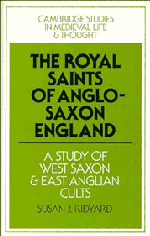Book contents
- Frontmatter
- Contents
- Dedication
- Acknowledgements
- List of abbreviations
- 1 The royal saints of Anglo-Saxon England: some problems of interpretation
- 2 The sources
- 3 Royal birth and the foundations of sanctity: theoretical interpretations
- 4 The cult of St Edburga at Winchester and Pershore
- 5 The children of Edgar
- 6 The royal cults of Ely
- 7 The cult of St Edmund
- 8 Piety, patronage and politics: towards an understanding of the Anglo-Saxon royal cults
- Appendix 1 The Life of St Edburga of Winchester by Osbert of Clare, prior of Westminster
- Appendix 2 Two items concerning St Edburga of Winchester from Oxford, Bodleian Library, MS Bodley 451
- Bibliography
- Index
1 - The royal saints of Anglo-Saxon England: some problems of interpretation
Published online by Cambridge University Press: 11 May 2010
- Frontmatter
- Contents
- Dedication
- Acknowledgements
- List of abbreviations
- 1 The royal saints of Anglo-Saxon England: some problems of interpretation
- 2 The sources
- 3 Royal birth and the foundations of sanctity: theoretical interpretations
- 4 The cult of St Edburga at Winchester and Pershore
- 5 The children of Edgar
- 6 The royal cults of Ely
- 7 The cult of St Edmund
- 8 Piety, patronage and politics: towards an understanding of the Anglo-Saxon royal cults
- Appendix 1 The Life of St Edburga of Winchester by Osbert of Clare, prior of Westminster
- Appendix 2 Two items concerning St Edburga of Winchester from Oxford, Bodleian Library, MS Bodley 451
- Bibliography
- Index
Summary
In the early days of January, in the momentous year 1066, ‘King Edward, the beloved of God, languishing from the sickness of soul he had contracted, died indeed to the world, but was joyfully taken up to live with God.’ Thus wrote Edward's earliest biographer, probably within two years of his death. And almost a century later, on 7 February 1161, the apotheosis which he describes received universal recognition when Pope Alexander III announced the canonisation of Edward and decreed that his name should be enrolled among the confessors of the Christian church.
Edward the Confessor was the last and most famous of the Anglo-Saxon royal saints: but he was far from unique. It is clear from Bede's Historia ecclesiastica gentis Anglorum, completed in the year 731, that already by that date Anglo-Saxon England was remarkable for the very considerable number of its kings, princes and royal ladies who, in an age before the development of papal canonisation, had come to be venerated as saints by the regional church. A vernacular tract on the resting-places of the saints in England not only includes many royal saints but also is associated in its extant manuscripts with the so-called Kentish royal legend – an account of Kent's earliest Christian kings and their saintly families. Towards the end of the eleventh century the professional hagiographer Goscelin of Canterbury produced an impressive series of Lives of the English royal saints.
- Type
- Chapter
- Information
- The Royal Saints of Anglo-Saxon EnglandA Study of West Saxon and East Anglian Cults, pp. 1 - 7Publisher: Cambridge University PressPrint publication year: 1989

